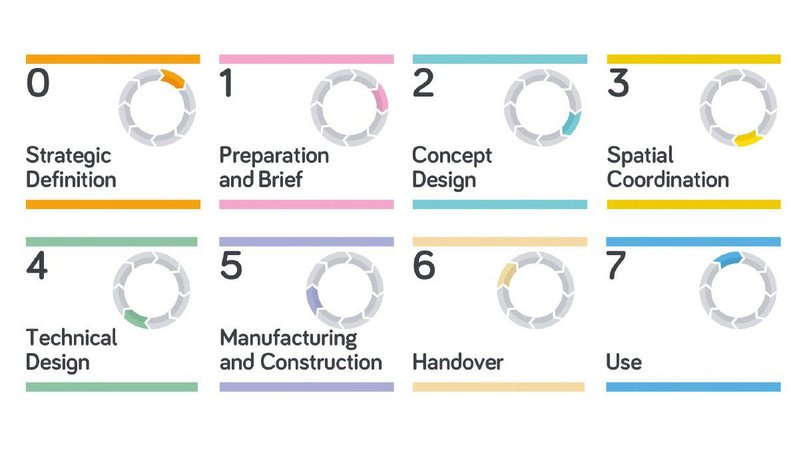This article provides you with an insight into how the Royal Institute of British Architects (RIBA) new 2020 Plan of Work may impact the design process amongst various stakeholders external to the project team, including the local community and residents, throughout the design stages for a new development, master plans, and placemaking projects.

The RIBA Plan of Work consists of recommendations to guide project teams (client, design, construction) through the principal works delivered at each stage. The framework was first introduced in 1964 in the UK as a project-agnostic process map of best practice for project teams involved in the production of a building project (architects, surveyors, engineers, clerk of works, planning officers, etc.). It presents an integrated plan for the project teams to acknowledge the heuristic behaviour of the project and the expectation of tasks to be completed through the process.
The recent decade has seen a number of significant changes influencing architecture, engineering and construction (AEC) industry, which required an update to the RIBA Plan of Work. Since its conception, there has been a substantial shift in the future goals for development projects to respond to a greater focus on sustainability and responsibility. Changes in planning legislation introduced greater focus on accountability towards stakeholders of the built environment throughout the design process. In addition, the reformation of planning regulations in England and Wales towards greater involvement of stakeholders also raises questions for architects how best to involve stakeholders in the shaping of new developments. And many architecture firms have moved to adopt digital tools to support design collaboration to achieve better decision making in areas of procurement, design and construction. This has encouraged new industry standards which has been reflected in the Government’s Industrial Strategy 2016-20, with an emphasis in the integration of techniques such as Building Information Modelling (BIM), handling of information requirements, and Government-recommended standards for soft landings.
The diversity of development projects in the United Kingdom will always vary from project to project, which naturally makes it more challenging to provide a common set of guidelines that reflects all eventualities. To tackle this, the 2020 RIBA Plan of Work now includes various project strategies that present project teams fitting goals and advice for their specific built environment project. The key core strategies of relevance to stakeholder engagement are the Inclusive Design Strategy, the Planning Strategy, and the Plan for Use strategy. Other strategies cover Conservation, Fire Safety, Health and Safety, Procurement, and Sustainability.
This blog will review guidance in the Plan of Work that are likely to impact stakeholder engagement. Therefore, this will focus on the stages of design development, that being strategic definition (RIBA Stage 0), preparation and briefing (RIBA Stage 1), concept design (RIBA Stage 2), and spatial coordination (RIBA Stage 3). Specifically, this article looks at the focus on 'planning for purpose' during design development, the identification and involvement of project stakeholders, the increasing emphasis of Inclusive Design.
Planning strategy
"Good planning is inseparable from good design and vice versa. Assessing planning issues should not be left to Stage 3 but be evaluated from the outset of every commission. For example, will the Client Requirements be acceptable under planning policy? If not, there is no value in developing design solutions for a proposal that is unlikely to gain consent. ” RIBA Plan of Work (P.34)
The architecture, engineering and construction industry has matured alongside the reformation of the planning regulations. In England and Wales, for instance, the National Planning Policy Framework of the last decade has emphasised on early, proportionate, and effective engagement between plan makers and communities. Instruments such as the Community Infrastructure Levy promise greater benefits for local communities from new development. The recently published 2020 RIBA Plan of Work reflects the last decade’s shift towards accountability and a tighter commitment to the planning process to avoid disruptions.
An illustration of this is the development of planning for purpose. The development of plan-making within the National Planning Policy Framework has developed to integrate a social objective as part of its move towards sustainable development. Plans and new development are seen as more effective when shaped early with proportionate and effective engagement between plan makers and communities, local organizations and infrastructure providers.
Undertaking community engagement is generally good practice, but not necessarily always legally required. Read our article to understand when you are legally obliged to submit a Statement of Community Involvement with your application.
The RIBA Plan of Work now presents a focus on project teams reviewing past feedback from planning history and being able to understand the context of the area to plan the necessary expertise needed within the design stages of the project. Complying with more reflective design procedures considers more stakeholders who might benefit from the changes to the built environment. It presents more challenges, but it provides a strategy which would affect the longevity of the project.
Unlike that of the 2013 Plan of Work – the development stages that include planning now presents greater detail of what should be expected from clients, designers, and project leads in the effect of planning. The RIBA Plan of Work makes the following recommendation in order to approach planning with a purpose:
Stage 0 — Strategic Definition
Stage 1 — Preparation and Briefing
Stage 2 — Concept Design
Stage 3 — Spatial Coordination
Identifying project stakeholders
Success of a project can be ensured through the cohesion of the client team, design team, and construction team; however, the 2020 RIBA Plan of Work also takes greater recognition that project stakeholders are also comprised of important external stakeholders, such as planning departments, building control teams, utilities companies, community groups, environmental bodies, specialist interest groups, insurance and warranty providers. While usually there are no contractual agreements with any of those external stakeholders; project managers are advised to proactively manage and consider the input and involvement of these groups early on.
In response to the Grenfell Disaster, there has been an increasing emphasis in recognizing these projects stakeholders with the architecture, engineering and construction industry procedure having recently been scrutinized. Various main players of the industry (architects, construction, developers, etc) have been criticised for how they have approached areas of the project's development and handoff. This has created greater focus on the industry’s responsibility towards community stakeholders. Reflection on the Grenfell Disaster and its national impact has made the industry think about the later users of the built environment, but also greater input and involvement of external stakeholders in the design process for new development. The Hackett Report, or the Independent Review of Building Regulations and Fire Safety final report presents the various consequences that came from ignorance, indifference, lack of clarity of roles and inadequate regulatory oversight and enforcement tools. Partially the report presents a focus on the roles and responsibilities of those procuring, designing, constructing and maintaining buildings towards building users are unclear and the voices of residents often going unheard.
The Plan of Work now takes greater account of the changing values within the architecture, engineering and construction industry especially with the developing insight and processes to support soft landings and a better hand over to future building users. This has been reflected in the Plan of Work with the sixth stage no longer stating the handover with the ‘close out’ and collecting feedback from building users earlier and systematically before a formal post occupancy evaluation.
To find out how to embedd engagement activities aligned with your design process, have a look at this article here: Two engagement strategies for your next residential master plan.
Inclusive Design
The RIBA Plan of Work advises project managers to identify stakeholders external to the project team early within the project to open opportunities to share ideas with regard to access and design. Specifically, project managers who focus on inclusive design as a core strategy will present various stakeholders not usually involved in design more significant in the design process. A design process is inclusive when the design objectives are optimized for a specific user with specific needs. The Inclusive Design Strategy focuses on accessibility and inclusion for people with disabilities, which is a firm policy of Government. It also reflects the cultural zeitgeist as this policy reflects the specific aspirations and expectations of the general public.
The RIBA Plan of Work Inclusive Design Strategy focuses upon the client team ensuring they have adequate resources allocated to develop a design which corresponds to the needs of future building users that a building might have throughout its lifespan, especially those with specific access and usage requirements. This is reflected in its attention towards planning legislation, policy and procedure and the importance of understanding how complex the consideration of user needs can be as part of the design process.
Focus on using the Inclusive Design Strategy is presented as:
Stage 0 — Strategic Definition
Stage 1 — Preparation and Briefing
Stage 2 — Concept Design
Stage 3 — Spatial Coordination
Conclusion
The updates made to the 2020 version of the RIBA Plan of Work reflect changes within the expectations of the architecture, engineering and construction industry that have arisen in the last seven years since it was last updated. The updates surround project strategies such as planning, planning for use, and inclusive Design. This is of course a neutral tool designed by RIBA to aid the project’s teams (developers, architects, and clients) through the building lifecycle.
In the 2020 Plan of Work, project stakeholders are included as a significant aspect of the project’s development. Recent examples of the risks of reduced scrutiny of proposals also by end users in inclusive design and planning support the need for greater awareness for the various ways to consult with external project stakeholders and communities, and to see them as contributors in the design process prior to any technical development. Hence there’s greater need to develop suitable means for external project stakeholders to be broad into the design process in a manner that is productive to design development.
Interested to layer on meaningful online engagement campaigns to a project of your own?
